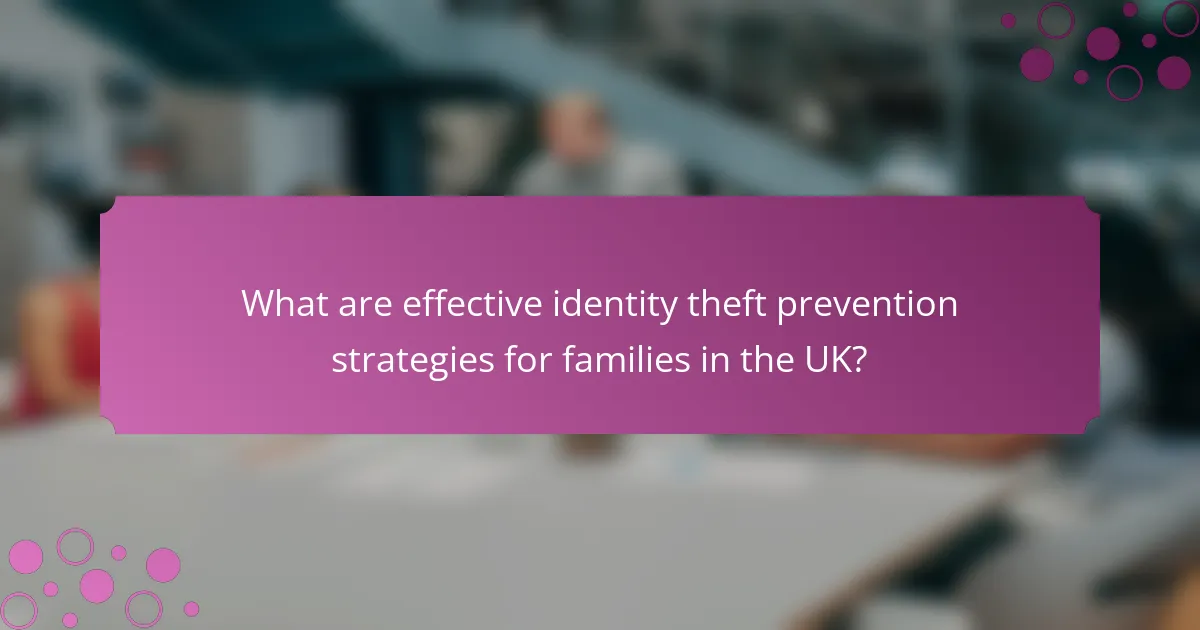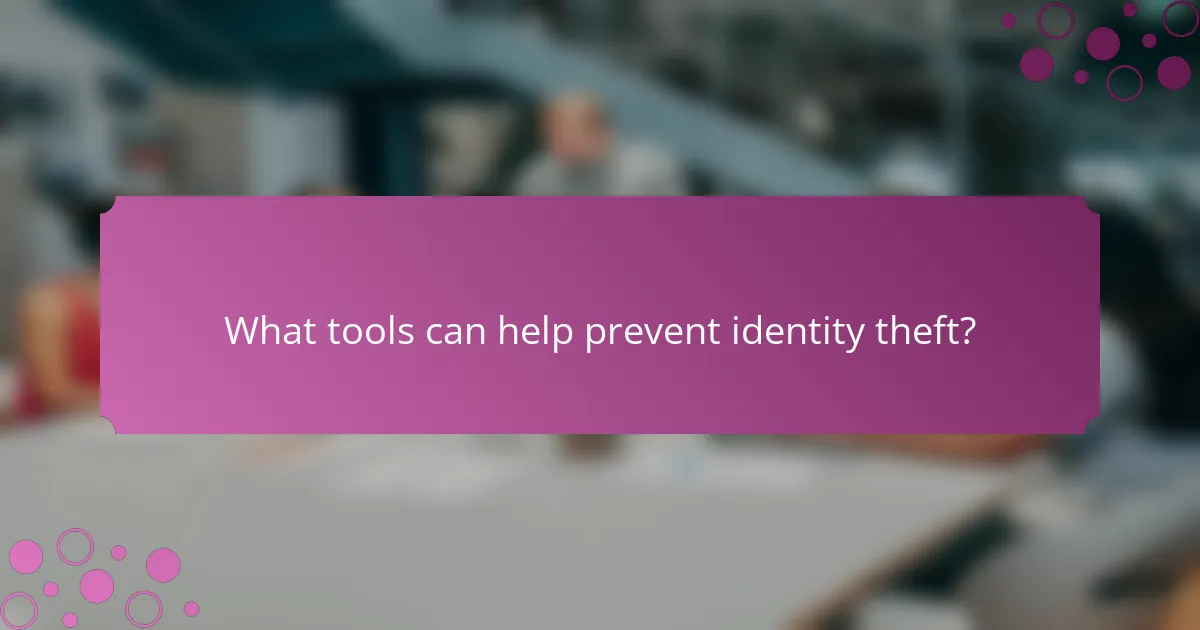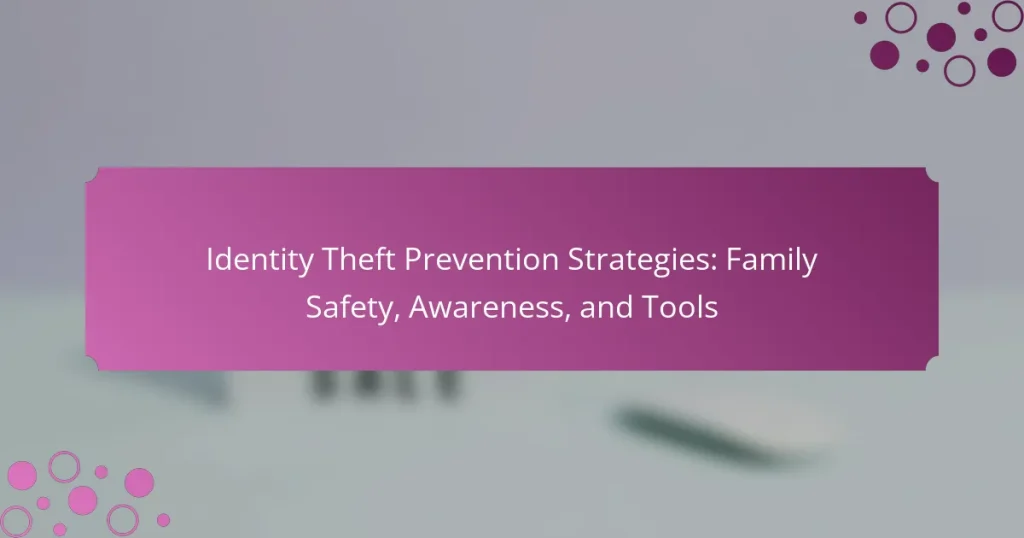Identity theft is a growing concern for families, making it essential to adopt effective prevention strategies. By regularly monitoring credit reports, using identity protection services, and educating family members about potential scams, households can significantly reduce their risk. Additionally, implementing strong passwords and actively overseeing financial accounts are vital steps in safeguarding personal information.

What are effective identity theft prevention strategies for families in the UK?
Effective identity theft prevention strategies for families in the UK include regular monitoring of credit reports, utilizing identity theft protection services, and educating family members about potential scams. Implementing strong passwords and actively monitoring financial accounts are also crucial steps to safeguard personal information.
Regular credit report checks
Regularly checking credit reports is essential for detecting any unauthorized activity. Families should obtain their credit reports at least once a year from the three main credit reference agencies in the UK: Experian, Equifax, and TransUnion. This allows for early identification of discrepancies that may indicate identity theft.
When reviewing credit reports, look for unfamiliar accounts or inquiries. If anything seems suspicious, it’s important to act quickly by contacting the credit agency and the relevant financial institutions.
Use of identity theft protection services
Identity theft protection services can provide an added layer of security for families. These services typically monitor personal information across various databases and alert users to potential threats. Many services also offer recovery assistance if identity theft occurs.
When choosing a service, consider factors such as coverage, cost, and customer reviews. Some services may include features like credit monitoring, identity restoration, and insurance against losses, making them worthwhile investments for family safety.
Implementing strong passwords
Creating strong passwords is a fundamental step in preventing identity theft. Families should use unique passwords for different accounts, incorporating a mix of letters, numbers, and symbols. A password manager can help generate and store complex passwords securely.
Additionally, enabling two-factor authentication (2FA) wherever possible adds an extra layer of protection. This requires a second form of verification, such as a text message code, making it harder for unauthorized users to access accounts.
Educating family members on phishing scams
Education is key in preventing identity theft through phishing scams. Families should be aware of common tactics used by scammers, such as emails or messages that appear to be from legitimate sources asking for personal information.
Encourage family members to verify the sender’s identity before clicking on links or providing sensitive information. Regular discussions about recent scams can help keep everyone informed and vigilant against potential threats.
Monitoring financial accounts
Regularly monitoring financial accounts is crucial for spotting unauthorized transactions early. Families should review bank and credit card statements frequently, ideally on a weekly basis, to ensure all charges are legitimate.
Setting up alerts for transactions can also help in monitoring accounts. Many banks offer notifications for large purchases or unusual activity, allowing families to respond quickly if something seems off.

How can families raise awareness about identity theft?
Families can raise awareness about identity theft by educating each member on the risks and preventive measures. This involves open discussions, sharing experiences, and utilizing available resources to stay informed about identity protection strategies.
Conducting family workshops
Hosting family workshops is an effective way to engage everyone in discussions about identity theft. These workshops can cover topics such as recognizing phishing attempts, securing personal information, and understanding the importance of strong passwords. Encourage participation by making the sessions interactive, allowing family members to ask questions and share their thoughts.
Consider scheduling these workshops regularly, perhaps once a month, to keep the conversation ongoing and relevant. Use real-life scenarios to illustrate points and reinforce learning.
Sharing real-life identity theft stories
Sharing real-life stories about identity theft can make the issue more relatable and urgent for family members. Discussing cases where individuals have faced significant consequences can highlight the importance of vigilance. Encourage family members to share any personal experiences or stories they’ve heard from friends or media.
These narratives can serve as cautionary tales, prompting discussions about what could have been done differently to prevent the theft. This approach fosters a deeper understanding of the risks involved.
Utilizing online resources and guides
There are numerous online resources and guides available that can help families understand identity theft better. Websites from government agencies, such as the Federal Trade Commission (FTC) in the U.S., provide valuable information on prevention strategies and steps to take if identity theft occurs. Bookmark these resources for easy access.
Additionally, consider using tools like identity theft protection services that offer monitoring and alerts. Many of these services provide educational materials that can further enhance your family’s knowledge and preparedness against identity theft.

What tools can help prevent identity theft?
Several tools can effectively help prevent identity theft by monitoring personal information and securing sensitive data. Utilizing software and services designed for identity protection can significantly reduce the risk of unauthorized access to your identity.
IdentityGuard software
IdentityGuard software offers comprehensive identity theft protection by monitoring personal information across various platforms. It tracks changes in your credit report and alerts you to suspicious activity, helping you take immediate action if necessary.
When considering IdentityGuard, evaluate its features such as credit monitoring, identity theft insurance, and recovery assistance. Pricing typically ranges from $8 to $25 per month, depending on the level of service you choose.
LifeLock services
LifeLock provides identity theft protection services that include credit monitoring and alerts for potential identity fraud. They offer a range of plans with varying levels of coverage, including identity restoration services and insurance against losses due to identity theft.
LifeLock’s pricing can vary from around $10 to $30 per month, depending on the features included. Users should assess their specific needs, such as family coverage or additional monitoring services, to select the right plan.
Credit monitoring apps
Credit monitoring apps help you keep an eye on your credit score and report, alerting you to any significant changes. These apps often provide insights into your credit utilization and can help identify potential fraud early.
Popular credit monitoring apps include Credit Karma and Experian, which are often free to use. However, premium features may come at a cost, so it’s wise to compare options based on your monitoring needs and budget.
Secure document storage solutions
Secure document storage solutions protect sensitive information by encrypting files and storing them in a secure environment. Options like cloud storage services with strong security measures can help keep personal documents safe from unauthorized access.
When choosing a storage solution, look for features such as end-to-end encryption and multi-factor authentication. Services like Google Drive and Dropbox offer secure options, but ensure you understand their privacy policies and security protocols before storing sensitive data.

What are the signs of identity theft?
Signs of identity theft can include unfamiliar transactions, unexpected bills, and changes in your credit report. Recognizing these indicators early can help you take swift action to protect your financial identity.
Unfamiliar transactions on accounts
One of the most immediate signs of identity theft is discovering transactions on your accounts that you do not recognize. This could range from small purchases to larger sums, often indicating that someone else has gained access to your financial information.
Regularly reviewing your bank and credit card statements can help you spot these unfamiliar transactions quickly. If you notice anything suspicious, report it to your bank or credit card issuer immediately to mitigate potential losses.
Receiving bills for accounts you did not open
Receiving bills for accounts you did not open is another clear sign of identity theft. This may include credit card statements, loan notices, or utility bills that you have no knowledge of.
If you receive such bills, it’s crucial to contact the company immediately to dispute the charges and investigate how your information was compromised. Keeping a close eye on your mail and electronic statements can help you catch these issues early.
Unexpected credit report changes
Unexpected changes in your credit report can signal identity theft. This may include new accounts opened in your name or significant drops in your credit score without explanation.
Monitoring your credit report regularly is essential. You can obtain a free report annually from each of the major credit bureaus. If you notice any discrepancies, dispute them right away and consider placing a fraud alert or credit freeze on your accounts to prevent further damage.

How can families create a response plan for identity theft?
Families can create a response plan for identity theft by establishing clear protocols for monitoring personal information and responding to potential threats. This includes designating roles for each family member, maintaining updated records, and knowing whom to contact in case of a breach.
Steps to take immediately after theft
After discovering identity theft, the first step is to secure your accounts. Change passwords for online banking, email, and any other sensitive accounts immediately. Use strong, unique passwords and consider enabling two-factor authentication for added security.
Next, report the theft to relevant authorities. Contact your bank and credit card companies to inform them of the situation, and consider placing a fraud alert on your credit reports. This alert can help prevent further unauthorized access to your accounts.
Lastly, document everything. Keep a record of all communications and actions taken, including dates, times, and names of representatives you speak with. This documentation can be crucial for resolving disputes and restoring your identity.


